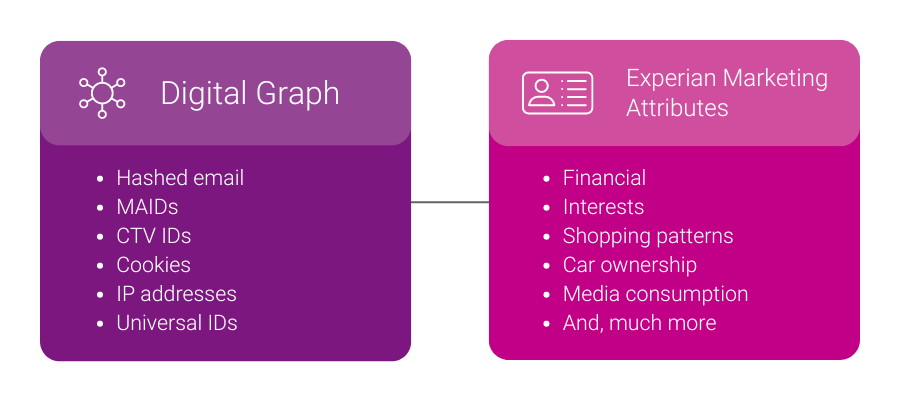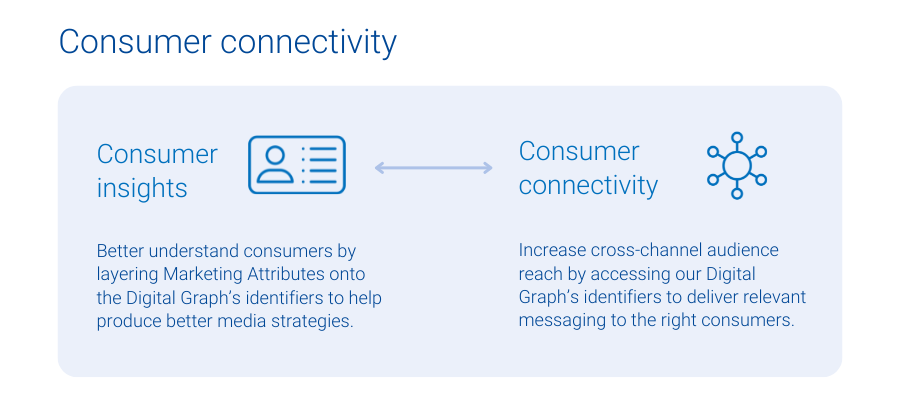
Experian, the leader in powering data-driven advertising through connectivity, is thrilled to unveil our latest solution, Digital Graph and Marketing Attributes. This joint solution supplies marketers and platforms with the insights and connectivity needed to understand who their customers are and reach them across digital channels.
The uncertainty around third-party cookies in Chrome and the overall decline in signal complicates the industry’s ability to reach the right consumer. Omnichannel media consumption results in scattered data, making it harder for marketers and platforms to understand consumer behavior and reach them across channels. These challenges call for a comprehensive solution.
Our Digital Graph and Marketing Attributes solution addresses these challenges by providing identifiers for seamless cross-channel engagement. By adding Marketing Attributes, like demographic and behavioral data, marketers and platforms also gain a better understanding of their customers. This solution uses Experian’s Living Unit ID (LUID) to combine offline and digital data, giving customers deeper insights into consumer behavior, greater audience reach, and improved cross-channel visibility.

Benefits of Digital Graph and Marketing Attributes
Both our Digital Graph and Marketing Attributes provide value to clients as standalone products. When clients license our Digital Graph and Marketing Attributes joint solution, they have more data at their fingertips, unlocking:
- Consumer connectivity: When clients license Experian’s Digital Graph, they get access to digital identifiers like mobile ad IDs (MAIDs), connected TV (CTV) IDs, hashed emails (HEMs), and universal IDs so they can target the right consumers with the relevant messages across all digital media channels.
- Consumer insights: Experian’s 5,000 Marketing Attributes provide our clients with detailed consumer information and insights, such as age, gender, purchase behaviors, and content consumption habits. Marketing Attributes help clients create more relevant messaging and informed audience segmentation.

Client examples
How OpenX offers richer targeting and more connectivity with Experian
OpenX is an independent omni-channel supply-side platform (SSP) and a global leader in audience, data, and identity-targeting. With industry-leading technology, exceptional client service, and extensive scalability across all formats, including CTV, app, mobile web, and desktop, OpenX has a legacy of innovating products that enhance buyer outcomes and publisher revenue while addressing complex challenges in programmatic.
In recent years, OpenX has licensed Experian’s Digital Graph with identifiers, contributing to the SSP’s largest independent supply-side identity graph, which offers advanced audiences to buyers and improved data resolution to content owners.
More recently, OpenX licensed Experian’s Marketing Attributes to enrich its supply-side identity graph, which includes IPs, MAIDs, and client IDs, with a variety of attributes. This strategic move has helped OpenX’s clients benefit from enhanced consumer insights and addressability, in turn delivering greater reach to the demand side and higher revenue for publishers, despite industry signal loss.
“We built on our long-term partnership with Experian to enrich our digital IDs with Experian’s Marketing Attributes, which help provide buyers better insights to audiences, thereby helping our publishers monetize their inventory. With partners like Experian, OpenX effectively facilitates the value exchange between demand and supply, ensuring our partners are able to drive results for their business in the era of signal loss”
Craig Golaszewski, Sr. Director of Strategic Partnerships, OpenX
How StackAdapt licenses our product bundle to address three different use cases
StackAdapt is the multi-channel programmatic advertising platform trusted by marketers to deliver exceptional campaigns. They drive superior results through a variety of solutions, like contextual and first-party targeting, brand lift measurement, and optimization through insights.
StackAdapt licensed a similar yet unique product combination, our Digital Graph and our Audiences. StackAdapt uses the Digital Graph to allow clients to onboard their first-party data in a seamless, self-serve manner that allows them to further segment their data using Experian Audiences.
“StackAdapt has been recognized as the most trusted programmatic platform by marketers, and with the integration of Experian’s Digital Graph and Audiences, we are strengthening our leadership in the space. This partnership improves our ability to deliver precise cross-channel segmentation, reach, and measurement, helping advertisers run more successful campaigns. Our collaboration with Experian allows us to offer a differentiated solution in the market and ensure our clients can deliver the most precise and impactful ads to their audiences.”
Denis Loboda, Senior Director of Data, StackAdapt
We recently announced a new partnership with StackAdapt. This collaboration brings the power of Experian’s identity graph, syndicated and custom audiences directly to the StackAdapt platform. Read the full details in our press release here.
Four ways to use Digital Graph and Marketing Attributes
When these two products come together, our clients have a 360-degree view of their consumers, which helps them power four critical use cases:
- Analytics and insights: Learn more about your consumers by connecting our Marketing Attributes with our Digital Graph’s identifiers. For example, a retailer can discover that their recent customers over-index as pickleball fans and players, leading the retailer to sponsor a professional pickleball event.
- Inventory monetization: When supply-side partners know their audience better, they can attract advertisers in search of that audience. For example, a publisher might find out that their audience is full of pickleball fans, leading them to reach out to brands that want to reach this audience.
- Activation: Companies with access to more digital identifiers from our Digital Graph can reach more people, while controlling frequency across channels. A company might know that they want to reach pickleball fans. Now, they have the digital identifiers needed to reach pickleball fans across all digital channels where they consume content, leading to increased reach.
- Measurement and attribution: Use the Digital Graph’s support for various digital identifiers to understand all consumer touchpoints, from media impressions to conversions. Then, lean on our Marketing Attributes to determine who your messaging resonated with. For example, a company uses our Digital Graph to know if it was the same individual who was exposed to an ad on CTV and converted via e-commerce. On top of that, the company can use our Marketing Attributes data to find out that the people who purchased were overwhelmingly pickleball fans.
Connect with us to learn more about how our Digital Graph and Marketing Attributes joint solution can provide the data and insights you need to create, activate, and measure cross-channel media campaigns.
Latest posts

If you live in an early primary or caucus state, you’ve probably already had your fill of political advertising. According to The Washington Post, politicians and political groups spent more than $23 million on campaign television ads as of December 1, 2011. With record ad spending predicted for the 2012 election, the rest of the nation will soon be bombarded with television ads “approved by” politicians from the left, right and the center of the political spectrum. Candidates and those groups that support them need to know where to allocate their ad dollars to either connect with their base or reach swing voters. Experian Simmons analyzed the viewing audiences of over 600 broadcast, cable and syndicated TV programs that were measured in our most recent National Consumer Study in order to pinpoint opportunities for politicians to reach partisans and middle of the road voters. This analysis has already gathered the attention of major media outlets, including Entertainment Weekly, The Washington Post, AOL, Huffington Post and more. Below are the entertainment and news programs that score the highest concentration of liberal Democrats among their viewers, Conservative Republicans and Middle-of-the-Road Voters registered with any party. Be sure to check out our free 2011 PoliticalPersonas report in which Experian Simmons delivers the mindset of the American voter, including attitudes, brand preferences and their penchant for social media. You can also check out a similar analysis of TV preferences of political partisans that we conducted last year here and here.

Social media continues to be one of the fastest growing industries online. Between September 2010 and September 2011 visits to Social Networks and Forums have increased by nearly 11% and, if you saw my Internet clock blog last month, social media accounts for nearly a quarter of all time spent online. But when are people engaging with social media the most? We took a look at the UK Internet visits to the Social Networks and Forums category each month between 2009 and 2011. We then averaged those visits across the months to see the seasonal trends with social media. What this shows is that social media usage is at its lowest at the beginning of the year and climbs throughout the course of the year towards a peak in December. Over the last three years December has always seen the peak of online visits and in fact last Christmas Day Facebook overtook Google for the first time ever in terms of UK Internet visits. We know that Christmas is a very social time and a time for sharing messages with loved ones, friends and family, so the increased visits to social networks during December is to be expected. More generally, what this graph shows is that social media observes two seasonal trends. The first is an early summer peak in visits in June, before a decline in visits in July and August. This seasonal dip in July and August can be explained by summer holidays where people are more likely to go abroad and therefore less likely to be using social networks. The second seasonal trend is a recovery in visits in September and October before a yearly peak at Christmas. With students starting university terms, kids going back to school, and the working population returning from holiday this would account for the increased interaction in September and October before the Christmas surge. In particular what we’ve seen in September data is a resurgence in market share of visits to Facebook, which bounced back after the summer dip to account for nearly 52% of all visits to a social network. The message here for brands who want to capitalise on social media traffic is to start implementing their social strategy now rather than waiting for Christmas. As October is the second busiest month of the year for social media visits we are expecting over 800 million hours to be spent on social networks this month, which represents a huge opportunity to engage with new and existing customers online. Follow Hitwise UK on Twitter.

Marketing by mobile device is now as popular as ever as retailers send shoppers text messages with special offers and sales. More and more companies are also offering their own phone apps so customers can search for product information and deals on the go. With more than 80 million mobile internet users in the United States, retailers can really benefit from this communication channel. One perk for shoppers is that they no longer have to save and print out coupons from emails! Through their mobile phones, shoppers can receive texts about sales and coupons as they enter stores. They can keep track of their favorite stores and make a purchase anywhere/anytime. One perk for shoppers is that they no longer have to save and print out coupons from emails! All they have to do is show the coupon on their phone at the point of purchase to redeem their coupon. With “QR” bar codes or quick response codes directly on coupons on your phone, savings can be redeemed on the spot. While many people don’t know yet that they can use QR codes on a mobile device, retailers have only begun to take advantage of this technology and more customers are now able to scan items in a store and pay for it using their mobile phones. While it’s just the beginning of a new era, mobile marketing is taking us by storm and now is the perfect time to put this trend into effect.